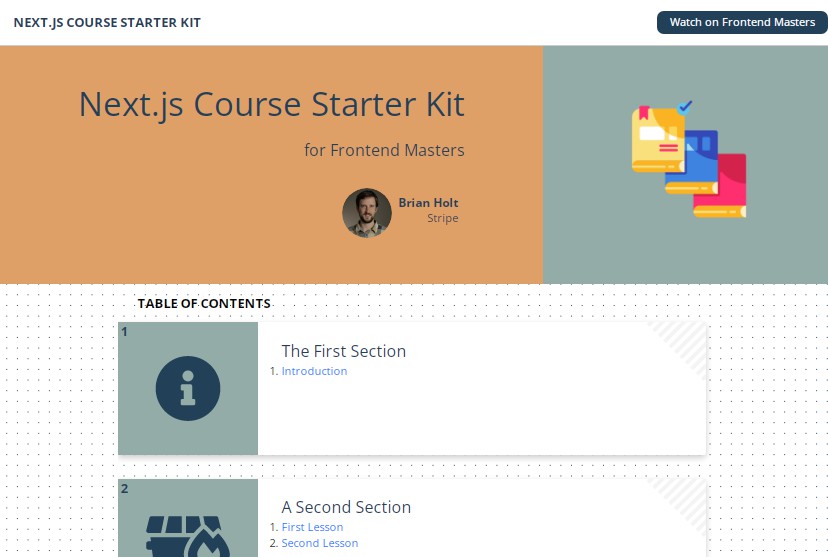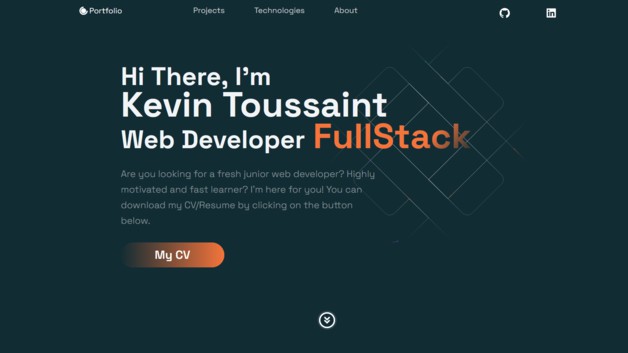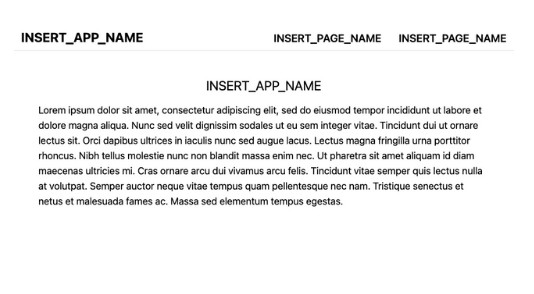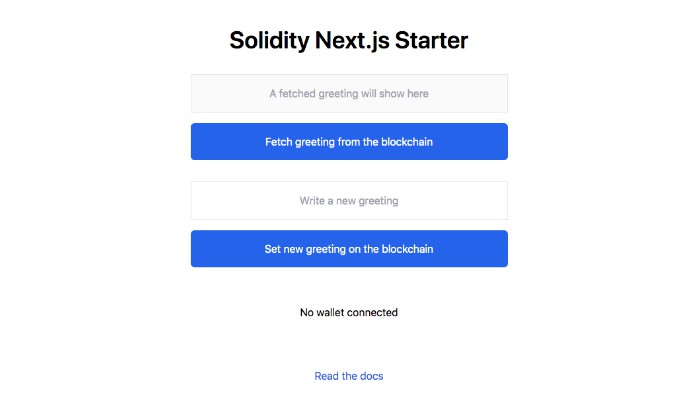next-course-starter
A NextJS starter to get you started creating educational materials using Markdown
Get Started
- Set up Node.js v14+
- Clone this repo
- Run
npm install - Run
npm run devto start the dev server - Open http://localhost:3000 in a browser
Configure Your Course
There are several things to configure before getting started.
course.json
This json file allows you to configure the details of the site. Update the info here and it’ll update it everywhere throughout the course website.
- author.name – Your name
- author.company – The company you work at or whatever you want as your subtitle. Optional.
- title – The title of your course
- subtitle – The subtitle of your course. Optional.
- frontendMastersLink – A link to the published video on FrontendMasters.com. Optional.
- social.linkedin – Your LinkedIn public user name, just the name, not the full link. Optional
- social.twitter – Your Twitter user name. Optional.
- social.github – Your GitHub user name. Optional.
- description – The description you want to show up in search engine results.
- keywords – The SEO keywords for this course. An array of strings
- productionBaseUrl – Typically useful for GitHub Pages. This adds a base path to your project. For GitHub Pages, this will be the name of your repo. For example, this site’s base URL is
/next-course-starterbecause the production URL for this site isbtholt.github.io/next-course-starer. Do note this will also make your dev server’s base URL this as well so you can catch problems before they go to production.
styles/variables.css
Here is where you can theme your site. You can retheme the whole site with just these.
public/images
Here is where you should stick all your images. Inside of your markdown, refer to images in this folder as ./images/<image file name>.
Note this site doesn’t use next/image because that requires the server component.
public/images/author.jpg
Your image. If you call it this, you won’t have to change any code. If you need to change it, it’s in pages/index.js.
public/images/social-share-cover.jpg
The image that will be used if someone shares your website to Twitter/Facebook/etc. If you call it this, you won’t have to change any code. If you do need to change it, it’s in pages/index.js
public/images/course-icon.png
The image at the top of the course. If you call it this, you won’t have to change any code. If you do need to change it, it’s in pages/index.js
Lessons
All your markdown lesson files will go in lessons/. They must be organized an named this way:
The folders must be named 01-section-one-name, 02-section-two-name, 03-section-three, etc.
The lessons are then grouped inside of these, the lessons are ordered by letters, A-lesson-one.md, B-lesson-two.md, C-lesson-three.md, etc. This numbering scheme matches how Frontend Masters organizes their content.
The titles of your lessons and sections are generated from the folder and lesson names (and can be overridden.) The first, organizing part of the name is stripped (the 01- part of 01-section-one and the A- part of A-lesson-one), the hyphens are turned into spaces (section-one becomes section one) and then those are run through title-case (so section one becomes Section One.) If you need to override these, use the frontmatter (explained below.)
The folder and lesson names are also used for the slugs. 02-section-two/C-lesson-three.md becomes yoursite.com/lessons/section-two/lesson-three.
Each of these lessons can have a frontmatter for the following properties
- title – If you want the title to be different from the file name, you can specify here what that title should be. Frequently this useful for things where the capitalization would be off e.g. TailwindCSS instead of Tailwindcss. Optional.
- description – If you want to give individual lessons descriptions for SEO and for Frontend Masters, you can write a brief description here.
Be aware because of how the numbers and letters are stripped out, it is possible to have ambigious paths. 01-welcome/A-intro.md and 03-welcome/D-intro.md would resolve to the same thing and only the first one would be visitable.
meta.json
Each section (e.g. inside of 03-section-three folder) folder can have a meta.json file, and is totally optional.
- title – an override for the title of the section. Frequently useful for capitalization e.g.
JS Toolsinstead ofJs Tools. - icon – so you can set the icon used in the home page and the header. These icons are pulled from the free Font Awesome v5 icons. If you want fa-hammer, use “hammer” as the value for icon.
highlight.js Theme
The code blocks use Highlight.js. By default it will use a11y-light as the theme for the code blocks. Change the CSS import in pages/_app.js to the theme you want to use.
GitHub Pages / GitHub Actions
By default this repo works with GitHub Pages. Just make sure you set the productionBaseUrl in the course.json to the name of the repo.
It also includes a GitHub Action to automatically deploy to your gh-pages branch. Just make sure that your repo has GitHub Pages enabled and the branch is set to gh-pages. If you’re not deploying to GitHub Pages go ahead and delete the .github directory.
By default the GitHub Action looks for a main branch, so be sure you’re using that instead of master.
Example Sites
CSV
Not implemented yet, but coming soon.
If you run npm run csv, a CSV will be generated with all the various lessons’ frontmatter outputted to public/lessons.csv. You can change the path by changing the OUTPUT_CSV_PATH environment variable.
Another CSV will be output to public/links.csv where it pull all the links out of each lesson and put them into a CSV. This path can be modified by setting the LINKS_CSV_PATH environment variable.
npm commands
npm run dev– Next’s dev command. Start a local dev server. Note if you have a productionBasePath set in your course.json, your dev server will respect that (so you don’t mess up your paths in production.)npm run build– Build your site for production. This will still include the Next.js server run time. Use this if you’re using something like Vercel to host your site.npm run export– Builds your site statically, use this if you’re going to deploy to GitHub Pages, S3, or somewhere else with no server. This will run next build and then next export (no need to run build yourself first.)npm run start– Start an already-built server.
License
The code is this repo is licensed under the Apache 2.0 license.
I include the CC-BY-NC-4.0 license for the content; this is what I recommend you license your content under: anyone can use and share the content but they cannot sell it; only you can.





